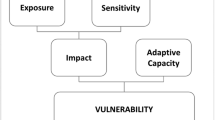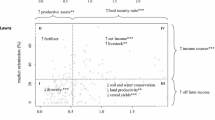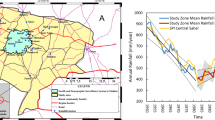Abstract
Agricultural landscapes are dynamic environments which change in response to cropping and trade opportunities, available technologies and climatic conditions. In this article, we investigate farmers’ vulnerability to climate-related stressors and crop price volatility in rural Navarre, Spain. Specifically, we analyse the extent to which livelihood differences and vulnerability can be partly explained by the development of a large-scale irrigation project promoted by the Spanish and regional governments. Grounded on qualitative and quantitative data gathered across 22 villages, we demonstrate that small-scale diversified farmers appear the most vulnerable and least able to adapt to climate-related stressors and crop price volatility. In contrast, more market-driven, large-scale intensive farmers, who participate in the irrigation project, are the least vulnerable to these stressors. We argue that the irrigation project has increased the short-term adaptive capacity of irrigation adopters while establishing the institutional conditions for the displacement of small-scale farming. Therefore, we suggest that farmers’ vulnerability in Navarre can be explained by maladaptive irrigation policies designed to favour large-scale and market-driven agriculture.





Similar content being viewed by others
Notes
When the project is concluded, the channel is expected to run for 177 km and to have irrigated 57,700 ha of farming land.
Communal land decrees refers to Foral Law 6/1986 -repealed by Foral Law 6/1990. Likewise, councils transforming communal lands can get a higher subsidy for the installation of irrigation technology if such councils prioritise full time farmers rather than other kind of farmers when allocating communal lands among the neighbouring farmers (Foral Order 186/2011 and Foral Order 185/2015).
Questions with too many missing values were removed before data analysis. When there were few missing values (e.g. < 10 missing data) it was retained, but respondents with missing values were removed from the analysis of such particular variable. Thus, the results rely on 364 respondents of the 381 total surveys performed.
Check the development of the index in the methods section and supplementary material. VI can take negative values when adaptive capacity (AC) values are higher than exposure (E) values.
‘Few’, ‘some’, ‘many’ and ‘most’ are used consistently to mean less than 25%, up to 50%, up to 74% and 75% or more of the corresponding sample, respectively.
A personal communication of an NGO technician revealed that those participating in the large-scale irrigation project accessed most of the available subsidies and received higher subsidies.
Also known as contract farming. Through these contracts, the farmers’ crop harvest will be sold to large-scale agribusinesses (German et al. 2011). Farmers and future buyers agree on a price for the harvest, which may be either above or below future market price, so farmers may either lose or win money. They accept the potential loss because they are guaranteed the purchase of the harvest.
References
Adger WN (2006) Vulnerability. Resil Vulnerability Adapt Cross-Cut Theme Int Hum Dimens Programme Glob Environ Change Resil Vulnerability Adapt Cross-Cut Theme Int Hum Dimens Programme Glob Environ Change 16:268–281. https://doi.org/10.1016/j.gloenvcha.2006.02.006
Ahmed SA, Diffenbaugh NS, Hertel TW (2009) Climate volatility deepens poverty vulnerability in developing countries. Environ Res Lett 4:034004
Albizua A, Williams A, Hedlund K, Pascual U (2015) Crop rotations including ley and manure can promote ecosystem services in conventional farming systems. Appl Soil Ecol 95:54–61. https://doi.org/10.1016/j.apsoil.2015.06.003
Albizua A, Pascual U, Corbera E, (2016) Social-ecological impacts of agrarian intensification: the case of modern irrigation in Navarre
Andreas J, Zhan S (2016) Hukou and land: market reform and rural displacement in China. J Peasant Stud 43:798–827. https://doi.org/10.1080/03066150.2015.1078317
Barnett J, O’Neill S (2010) Maladaptation. Glob Environ Chang 20(2):211–213. https://doi.org/10.1016/j.gloenvcha.2009.11.004
Beaumont MJ (1997) El embalse de Itoiz, la razón o el poder. Bakeaz
Berbel J, Mateos L (2014) Does investment in irrigation technology necessarily generate rebound effects? A simulation analysis based on an agro-economic model. Agric Syst 128:25–34. https://doi.org/10.1016/j.agsy.2014.04.002
Berkes F, Folke C, Gadgil M (1994) Traditional ecological knowledge, biodiversity, resilience and sustainability. In: Perrings CA, Mäler K-G, Folke C, Holling CS, Jansson B-O (eds) Biodiversity Conservation: Problems and Policies. Papers from the Biodiversity Programme Beijer International Institute of Ecological Economics Royal Swedish Academy of Sciences, Ecology, Economy & Environment. Springer, Dordrecht, pp 269–287. https://doi.org/10.1007/978-94-011-1006-8_15
Borras SMB, Franco JC (2011) Global land grabbing and trajectories of agrarian change: a preliminary analysis. J Agrar Chang 12:34–59. https://doi.org/10.1111/j.1471-0366.2011.00339.x
Cabello V, Willaarts BA, Aguilar M, del Moral Ituarte L (2015) River basins as social-ecological systems: linking levels of societal and ecosystem water metabolism in a semiarid watershed. Ecol Soc 20. https://doi.org/10.5751/ES-07778-200320
Calvário R (2017) Food sovereignty and new peasantries: on re-peasantization and counter-hegemonic contestations in the Basque territory. J Peasant Stud 44(2):402–420. https://doi.org/10.1080/03066150.2016.1259219
Campbell BM, Thornton P, Zougmore R, van Asten P, Lipper L (2014) Sustainable intensification: what is its role in climate smart agriculture? Curr Opin Environ Sustain 8:39–43. https://doi.org/10.1016/j.cosust.2014.07.002
Cinner JE, Adger WN, Allison EH, Barnes ML, Brown K, Cohen PJ, Gelcich S, Hicks CC, Hughes TP, Lau J, Marshall NA, Morrison TH (2018) Building adaptive capacity to climate change in tropical coastal communities. Nat Clim Chang 8:117–123. https://doi.org/10.1038/s41558-017-0065-x
Colloff MJ, Martin-Lopez B, Lavorel S, Locatelli B, Gorddard R, Longaretti P-Y, Walters G, van Kerkhoff L, Wyborn C, Coreau A, Wise RM, Dunlop M, Degeorges P, Grantham H, Overton IC, Williams RD, Doherty MD, Capon T, Sanderson T, Murphy HT (2017) An integrative research framework for enabling transformative adaptation. Environ Sci Pol 68:87–96. https://doi.org/10.1016/j.envsci.2016.11.007
Cox M, Ross JM (2011) Robustness and vulnerability of community irrigation systems: the case of the Taos valley acequias. J Environ Econ Manag 61(3):254–266. https://doi.org/10.1016/j.jeem.2010.10.004
De Vries A, Garcia M (2012) OTN Observaciones Territoriales de Navarra. Gobierno de Navarra, pp 1–20. http://nasuvinsa.es/sites/default/files/pdfs/Observacion4Agric_web.pdf
Diario de Noticias de Navarra (2016) La segunda fase del Canal “es desproporcionada y de alto coste”. [WWW Document]. URL http://www.noticiasdenavarra.com/2016/02/20/economia/la-segunda-fase-del-canal-es-desproporcionada-y-de-alto-coste. Accessed 2.22.16
Diario de Noticias de Navarra (2018) Canal de Navarra: sin agua para 21.500 nuevas ha. [WWW Document]. URL http://www.noticiasdenavarra.com/2018/03/23/opinion/tribunas/canal-de-navarra-sin-agua-para-21500-nuevas-ha. Accessed 5.16.18
Dirzo R, Raven PH (2003) Global state of biodiversity and loss. Annu Rev Environ Resour 28(1):137–167. https://doi.org/10.1146/annurev.energy.28.050302.105532
Dumenu WK, Obeng EA (2016) Climate change and rural communities in Ghana: social vulnerability, impacts, adaptations and policy implications. Environ Sci Pol 55:208–217. https://doi.org/10.1016/j.envsci.2015.10.010
Dwiartama A, Rosin C (2014) Exploring agency beyond humans: the compatibility of actor-network theory (ANT) and resilience thinking. Ecol Soc 19. https://doi.org/10.5751/ES-06805-190328
Eakin H, Bojórquez-Tapia LA (2008) Insights into the composition of household vulnerability from multicriteria decision analysis. Glob Environ Chang 18:112–127. https://doi.org/10.1016/j.gloenvcha.2007.09.001
Foley JA, DeFries R, Asner GP, Barford C, Bonan G, Carpenter SR, Chapin FS, Coe MT, Daily GC, Gibbs HK, Helkowski JH, Holloway T, Howard EA, Kucharik CJ, Monfreda C, Patz JA, Prentice IC, Ramankutty N, Snyder PK (2005) Global consequences of land use. Science 309:570–574. https://doi.org/10.1126/science.1111772
Ford JD, Smit B, Wandel J (2006) Vulnerability to climate change in the Arctic: a case study from Arctic Bay, Canada. Glob Environ Chang 16:145–160. https://doi.org/10.1016/j.gloenvcha.2005.11.007
García-Martín M, Plieninger T, Bieling C, García-Martín M, Plieninger T, Bieling C (2018) Dimensions of landscape stewardship across Europe: landscape values, place attachment, awareness, and personal responsibility. Sustainability 10:263. https://doi.org/10.3390/su10010263
Garrote L, Iglesias A, Granados A, Mediero L, Martin-Carrasco F (2015) Quantitative assessment of climate change vulnerability of irrigation demands in Mediterranean Europe. Water Resour Manag 29:325–338. https://doi.org/10.1007/s11269-014-0736-6
German L, Schoneveld G, Gumbo D (2011) The local social and environmental impacts of smallholder-based biofuel investments in Zambia. Ecol Soc 16(4):12. https://doi.org/10.5751/ES-04280-160412
Gobierno de Navarra (2015) Registro de explotaciones agrarias [WWW Document]. Obs. Agrar. URL http://www.navarra.es/home_es/Temas/Ambito+rural/Vida+rural/Observatorio+agrario/Agricola/Informacion+estadistica/Registro+de+explotaciones.htm. Accessed 29 Oct 2015
Gobierno de Navarra (2016) Estadísticas agrícolas. Producción agrícola. http://www.navarra.es/home_es/Temas/Ambito+rural/Vida+rural/Observatorio+agrario/Agricola/Informacion+estadistica/produccion+agricola.htm
Hahn MB, Riederer AM, Foster SO (2009) The livelihood vulnerability index: a pragmatic approach to assessing risks from climate variability and change—a case study in Mozambique. Glob Environ Chang 19:74–88. https://doi.org/10.1016/j.gloenvcha.2008.11.002
Hara MM, Backeberg GR (2014) An institutional approach for developing south African inland freshwater fisheries for improved food security and rural livelihoods. Water SA 40:277–286. https://doi.org/10.4314/wsa.v40i2.10
Huber García V, Gampe D, Ludwig R (2018) Estimating future water scarcity in two European river basins under different integrated climate, land use and water management scenarios. Presented at the EGU General Assembly Conference Abstracts, p 2848
Ifejika Speranza C, Wiesmann U, Rist S (2014) An indicator framework for assessing livelihood resilience in the context of social–ecological dynamics. Glob Environ Chang 28:109–119. https://doi.org/10.1016/j.gloenvcha.2014.06.005
INTIA (2016) Preguntas Clave Sobre el Embalse de Itoiz y el Canal de Navarra [WWW document]. URL http://www.intiasa.es/es/comunidad-de-regantes/areas-de-interes/itoiz-canal-de-navarra.html. Accessed 16 Feb 2017
IPCC (2007) Climate change 2007: impacts, adaptation and vulnerability. Contribution of Working Group II to the Fourth Assessment Report of the Intergovernmental Panel on Climate Change. Cambridge University Press. https://www.ipcc.ch/pdf/assessment-report/ar4/wg2/ar4_wg2_full_report.pdf
Larragueta (2012) Sector primario en Navarra
Lin K-HE, Polsky C (2015) Indexing livelihood vulnerability to the effects of typhoons in indigenous communities in Taiwan. Geogr J 182:135–152. https://doi.org/10.1111/geoj.12141
Maleksaeidi H, Karami E, Zamani GH, Rezaei-Moghaddam K, Hayati D, Masoudi M (2016) Discovering and characterizing farm households’ resilience under water scarcity. Environ Dev Sustain 18:499–525. https://doi.org/10.1007/s10668-015-9661-y
McGinnis M, Ostrom E (2014) Social-ecological system framework: initial changes and continuing challenges. Ecol Soc 19
Murgida AM, Gonzalez MH, Tiessen H (2014) Rainfall trends, land use change and adaptation in the Chaco salteo region of Argentina. Reg Environ Chang 14:1387–1394. https://doi.org/10.1007/s10113-013-0581-9
Notenbaert A, Karanja SN, Herrero M, Felisberto M, Moyo S (2013) Derivation of a household-level vulnerability index for empirically testing measures of adaptive capacity and vulnerability. Reg Environ Chang 13:459–470. https://doi.org/10.1007/s10113-012-0368-4
O’Brien K, Leichenko R, Kelkar U, Venema H, Aandahl G, Tompkins H, Javed A, Bhadwal S, Barg S, Nygaard L, West J (2004) Mapping vulnerability to multiple stressors: climate change and globalization in India. Glob Environ Chang 14:303–313. https://doi.org/10.1016/j.gloenvcha.2004.01.001
Partelow S, Winkler K (2016) Interlinking ecosystem services and Ostrom’s framework through orientation in sustainability research. Ecol Soc 21. https://doi.org/10.5751/ES-08524-210327
Rasmussen LV, Coolsaet B, Martin A, Mertz O, Pascual U, Corbera E, Dawson N, Fisher JA, Franks P, Ryan CM (2018) Social-ecological outcomes of agricultural intensification. Nat Sustain 1:275–282. https://doi.org/10.1038/s41893-018-0070-8
Rivera-Ferre MG (2008) The future of agriculture. EMBO Rep 9:1061–1066. https://doi.org/10.1038/embor.2008.196
Sanchis-Ibor C, Boelens R, García-Mollá M (2017) Collective irrigation reloaded. Re-collection and re-moralization of water management after privatization in Spain. Geoforum 87:38–47. https://doi.org/10.1016/j.geoforum.2017.10.002
Schröter D, Cramer W, Leemans R, Prentice CI, Araújo MB, Arnell NW, Bondeau A, Bugmann H, Carter TR, Gracia CA, Vega-Leinert AC, de la Erhard M, Ewert F, Glendining M, House JI, Kankaanpää S, Klein RJT, Lavorel S, Lindner M, Metzger MJ, Meyer J, Mitchell TD, Reginster I, Rounsevell M, Sabaté S, Sitch S, Smith B, Smith J, Smith P, Sykes MT, Thonicke K, Thuiller W, Tuck G, Zaehle S, Zierl B (2005) Ecosystem service supply and vulnerability to global change in Europe. Science 310:1333–1337. https://doi.org/10.1126/science.1115233
Smit B, Wandel J (2006) Adaptation, adaptive capacity and vulnerability. Glob. Environ. Change, Resilience, Vulnerability, and Adaptation: A Cross-Cutting Theme of the International Human Dimensions Programme on Global Environmental Change 16:282–292. https://doi.org/10.1016/j.gloenvcha.2006.03.008
Smith A, Stirling A (2010) The politics of social-ecological resilience and sustainable socio-technical transitions. Ecol Soc 15. https://doi.org/10.5751/ES-03218-150111
Tarjuelo JM, Rodriguez-Diaz JA, Abadía R, Camacho E, Rocamora C, Moreno MA (2015) Efficient water and energy use in irrigation modernization: lessons from Spanish case studies. Agric Water Manag 162:67–77. https://doi.org/10.1016/j.agwat.2015.08.009
Tilman D, Balzer C, Hill J, Befort BL (2011) Global food demand and the sustainable intensification of agriculture. Proc Natl Acad Sci 108:20260–20264. https://doi.org/10.1073/pnas.1116437108
Turner BL, Kasperson RE, Matson PA, McCarthy JJ, Corell RW, Christensen L, Eckley N, Kasperson JX, Luers A, Martello ML, Polsky C, Pulsipher A, Schiller A (2003) A framework for vulnerability analysis in sustainability science. Proc Natl Acad Sci 100:8074–8079. https://doi.org/10.1073/pnas.1231335100
Varela-Ortega C, Blanco-Gutierrez I, Esteve P, Bharwani S, Fronzek S, Downing TE (2016) How can irrigated agriculture adapt to climate change? Insights from the Guadiana Basin in Spain. Reg Environ Chang 16:59–70. https://doi.org/10.1007/s10113-014-0720-y
Yagiz S, Gokceoglu C (2010) Application of fuzzy inference system and nonlinear regression models for predicting rock brittleness. Expert Syst Appl 37:2265–2272
Acknowledgments
We would like to thank the insightful comments by Dalal Hanna and H.M. Tuihedur Rahman; Adam Searle for their help in proof-reading the paper. We would also like to thank two anonimous reviewers for their useful comments and suggestions. The usual disclaimer applies.
Funding
This article has received funds from the European Union Seventh Framework Programme (FP7/2007–2013) under the Grant agreement no.264465 (EcoFINDERS). This research is supported also by the Basque Government through the BERC 2018-2021 program and by Spanish Ministry of Economy and Competitiveness MINECO through BC3 María de Maeztu excellence accreditation MDM-2017-0714. Amaia Albizua also wants to thank the grant for contracts of Postdoctoral Training of the Education Department of the Basque Government. Esteve Corbera acknowledges the support of the Universitat Autònoma de Barcelona-Banco de Santander-Talent Retention Programme and the contribution of this article towards ICTA’s María de Maeztu Unit of Excellence 2015 (MDM-2015-0552).
Author information
Authors and Affiliations
Corresponding author
Additional information
Editor: Nicolas Dendoncker.
Publisher’s note
Springer Nature remains neutral with regard to jurisdictional claims in published maps and institutional affiliations.
Electronic supplementary material
ESM 1
(DOCX 147 kb)
Rights and permissions
About this article
Cite this article
Albizua, A., Corbera, E. & Pascual, U. Farmers’ vulnerability to global change in Navarre, Spain: large-scale irrigation as maladaptation. Reg Environ Change 19, 1147–1158 (2019). https://doi.org/10.1007/s10113-019-01462-2
Received:
Accepted:
Published:
Issue Date:
DOI: https://doi.org/10.1007/s10113-019-01462-2




